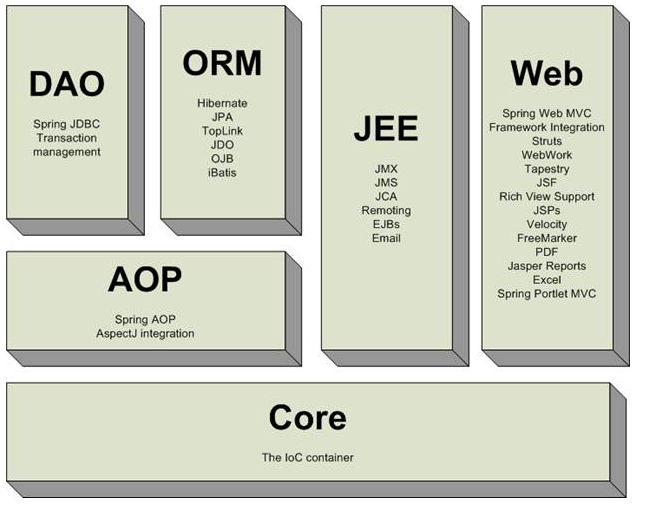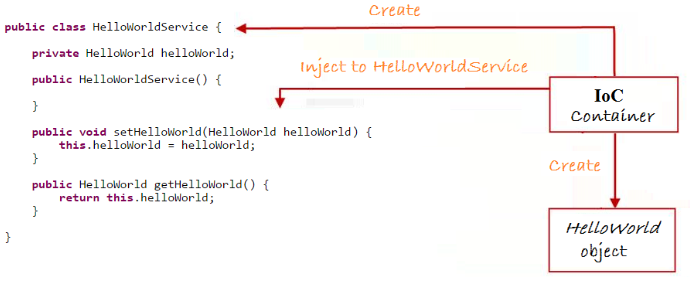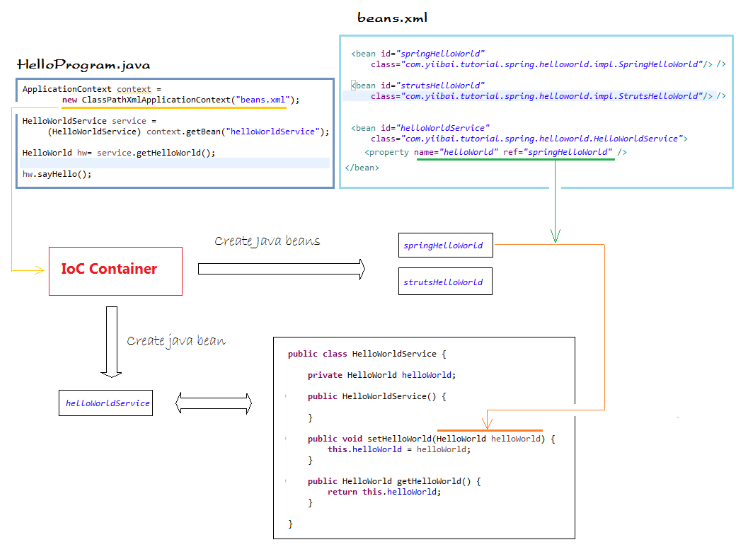Srping简介
广义上的 Spring 泛指以 Spring Framework 为核心的 Spring 技术栈。
经过十多年的发展,Spring 已经不再是一个单纯的应用框架,而是逐渐发展成为一个由多个不同子项目(模块)组成的成熟技术,例如 Spring Framework、Spring MVC、SpringBoot、Spring Cloud、Spring Data、Spring Security 等,其中 Spring Framework 是其他子项目的基础。
Spring 框架是一个分层的、面向切面的 Java 应用程序的一站式轻量级解决方案,它是 Spring 技术栈的核心和基础,是为了解决企业级应用开发的复杂性而创建的。
Spring 有两个核心部分: IoC 和 AOP。
IOC: Inverse of Control 的简写,译为“控制反转”,指把创建对象过程交给 Spring 进行管理。
AOP: Aspect Oriented Programming 的简写,译为“面向切面编程”。
AOP 用来封装多个类的公共行为,将那些与业务无关,却为业务模块所共同调用的逻辑封装起来,减少系统的重复代码,降低模块间的耦合度。另外,AOP 还解决一些系统层面上的问题,比如日志、事务、权限等。
Spring 是一种基于 Bean 的编程技术,它深刻地改变着 Java 开发世界。Spring 使用简单、基本的 Java Bean 来完成以前只有 EJB 才能完成的工作,使得很多复杂的代码变得优雅和简洁,避免了 EJB 臃肿、低效的开发模式,极大的方便项目的后期维护、升级和扩展。
在实际开发中,服务器端应用程序通常采用三层体系架构,分别为表现层(web)、业务逻辑层(service)、持久层(dao)。
Spring 致力于 Java EE 应用各层的解决方案,对每一层都提供了技术支持。
- 在表现层提供了对 Spring MVC、Struts2 等框架的整合;
- 在业务逻辑层提供了管理事务和记录日志的功能;
- 在持久层还可以整合 MyBatis、Hibernate 和 JdbcTemplate 等技术,对数据库进行访问。
spring 框架图:
反转控制和依赖注入
要了解这个问题,我们使用以下几类:
// Interface HelloWorld
public interface HelloWorld {
public void sayHello();
}
// Class implements HelloWorld
public class SpringHelloWorld implements HelloWorld {
public void sayHello() {
System.out.println("Spring say Hello!");
}
}
// Other class implements HelloWorld
public class StrutsHelloWorld implements HelloWorld {
public void sayHello() {
System.out.println("Struts say Hello!");
}
}
// And Service class
public class HelloWorldService {
// Field type HelloWorld
private HelloWorld helloWorld;
// Constructor HelloWorldService
// It initializes the values for the field 'helloWorld'
public HelloWorldService() {
this.helloWorld = new StrutsHelloWorld();
}
}
显而易见的是 HelloWorldService 类管理创建 HelloWorld 对象。 - 另外,在上述情况下,当 HelloWorldService 对象从它的构造创建时,HelloWorld对象也被创建了。 它是从StrutsHelloWorld 创建。
现在的问题是,您要创建一个HelloWorldService对象,HelloWorld对象也同时被创建,但它必须是SpringHelloWorld。 所以 HelloWorldService 是控制“对象创建” Hello World 的。我们为什么不创建 Hello World 转让由第三方, 而是使用 HelloWorldService ?因为我们有“反转控制”(IOC)的定义。 并且IoC容器将充当管理者角色,创建了HelloWorldService 和 HelloWorld 。
IoC = Inversion of Control

IoC容器创建 HelloWorldService 对象,是通过 setter 方法传递 HelloWorld 对象到HelloWorldService。IoC容器做的是“依赖注入”到HelloWorldService。这里的相关性是指对象之间的依赖关系: HelloWorldService 和 helloWorld.在这一点上,我们已经明确了什么是 IoC和DI。让我们举个例子来更好的理解。
声明Spring的基础库
这是 Spring的 HelloWorld 例子,所以我们只使用基本的Spring库(核心)。打开pom.xml文件来将使用的库声明:
• pom.xml 使用以下内容重新覆盖原上面的内容。
<project xmlns="http://maven.apache.org/POM/4.0.0"
xmlns:xsi="http://www.w3.org/2001/XMLSchema-instance"
xsi:schemaLocation="http://maven.apache.org/POM/4.0.0
http://maven.apache.org/xsd/maven-4.0.0.xsd">
<modelVersion>4.0.0</modelVersion>
<groupId>com.yiibai</groupId>
<artifactId>HelloSpring</artifactId>
<version>0.0.1-SNAPSHOT</version>
<dependencies>
<!-- Spring Core -->
<!-- http://mvnrepository.com/artifact/org.springframework/spring-core -->
<dependency>
<groupId>org.springframework</groupId>
<artifactId>spring-core</artifactId>
<version>4.1.4.RELEASE</version>
</dependency>
<!-- Spring Context -->
<!-- http://mvnrepository.com/artifact/org.springframework/spring-context -->
<dependency>
<groupId>org.springframework</groupId>
<artifactId>spring-context</artifactId>
<version>4.1.4.RELEASE</version>
</dependency>
</dependencies>
</project>
工程代码实例
- HelloWorld.java
package com.yiibai.tutorial.spring.helloworld;
public interface HelloWorld {
public void sayHello();
}
- HelloWorldService.java
package com.yiibai.tutorial.spring.helloworld;
public class HelloWorldService {
private HelloWorld helloWorld;
public HelloWorldService() {
}
public void setHelloWorld(HelloWorld helloWorld) {
this.helloWorld = helloWorld;
}
public HelloWorld getHelloWorld() {
return this.helloWorld;
}
}
- SpringHelloWorld.java
package com.yiibai.tutorial.spring.helloworld.impl;
import com.yiibai.tutorial.spring.helloworld.HelloWorld;
public class SpringHelloWorld implements HelloWorld {
@Override
public void sayHello() {
System.out.println("Spring Say Hello!!");
}
}
• StrutsHelloWorld.java
package com.yiibai.tutorial.spring.helloworld.impl;
import com.yiibai.tutorial.spring.helloworld.HelloWorld;
public class StrutsHelloWorld implements HelloWorld {
@Override
public void sayHello() {
System.out.println("Struts Say Hello!!");
}
}
- HelloProgram.java
package com.yiibai.tutorial.spring;
import com.yiibai.tutorial.spring.helloworld.HelloWorld;
import com.yiibai.tutorial.spring.helloworld.HelloWorldService;
import org.springframework.context.ApplicationContext;
import org.springframework.context.support.ClassPathXmlApplicationContext;
public class HelloProgram {
public static void main(String[] args) {
ApplicationContext context =
new ClassPathXmlApplicationContext("beans.xml");
HelloWorldService service =
(HelloWorldService) context.getBean("helloWorldService");
HelloWorld hw= service.getHelloWorld();
hw.sayHello();
}
}
- beans.xml
<beansxmlns="http://www.springframework.org/schema/beans"
xmlns:xsi="http://www.w3.org/2001/XMLSchema-instance"
xsi:schemaLocation="http://www.springframework.org/schema/beans
http://www.springframework.org/schema/beans/spring-beans.xsd">
<beanid="springHelloWorld"
class="com.yiibai.tutorial.spring.helloworld.impl.SpringHelloWorld"></bean>
<beanid="strutsHelloWorld"
class="com.yiibai.tutorial.spring.helloworld.impl.StrutsHelloWorld"></bean>
<beanid="helloWorldService"
class="com.yiibai.tutorial.spring.helloworld.HelloWorldService">
<propertyname="helloWorld"ref="springHelloWorld"/>
</bean>
</beans>
运行示例
运行 HelloProgram 类的结果如下:
打开 beans.xml 文件并更改配置:
<!-- Original -->
<beanid="helloWorldService"
class="com.yiibai.tutorial.spring.helloworld.HelloWorldService">
<propertyname="helloWorld"ref="springHelloWorld"/>
</bean>
<!-- Change to: -->
<beanid="helloWorldService"
class="com.yiibai.tutorial.spring.helloworld.HelloWorldService">
<propertyname="helloWorld"ref="strutsHelloWorld"/>
</bean>
Spring的工作原理
Spring在这个例子中,工作原理说明如下图所示:
beans.xml
• 这是一个配置文件,您可以在这里声明Java bean。
可以通过读取beans.xml 文件来创建一个应用程序上下文对象
ApplicationContext context = newClassPathXmlApplicationContext("beans.xml");
IoC容器中,其作用是作为第三种角色,它的任务是创建 beans.xml 文件中声明的 Java Bean 对象。并通过setter方法注入依赖
在这个例子中,HelloWorldService 是一个 java bean 注入依赖。
<!-- beans.xml -->
<beanid="helloWorldService"
class="com.yiibai.tutorial.spring.helloworld.HelloWorldService">
<!-- Call: helloWorldService.setHelloWorld(springHelloWorld) -->
<propertyname="helloWorld"ref="springHelloWorld"/>
</bean>

发表评论
取消回复